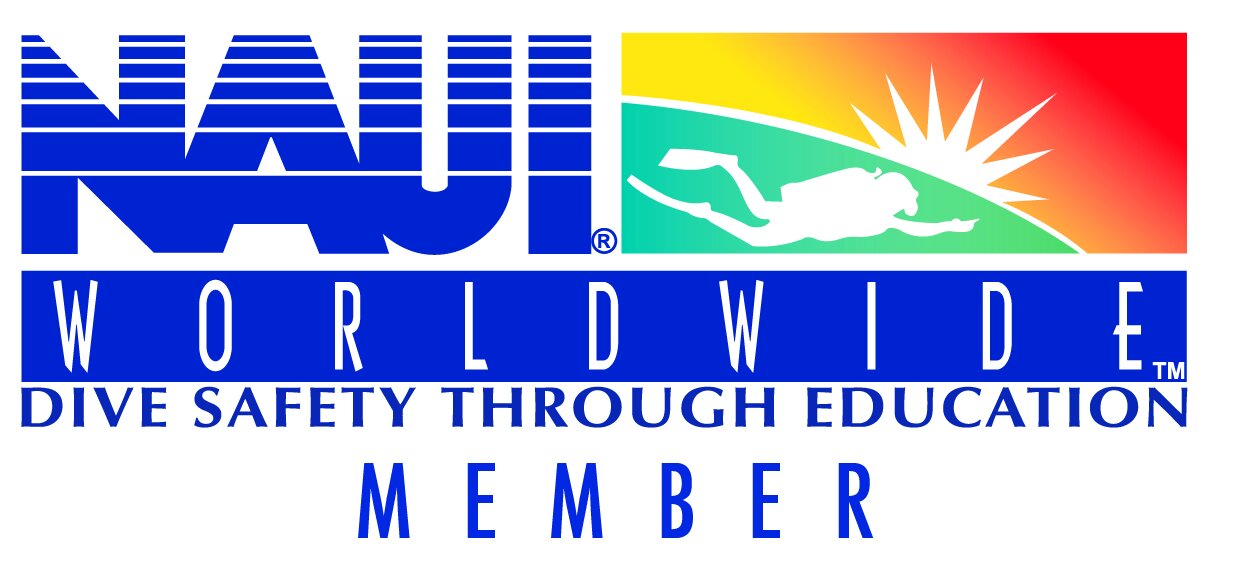
Learn to Dive
Become certified to SCUBA Dive with a NAUI certification
OVERVIEW AND QUALIFICATIONS
This course trains divers in the knowledge and skills needed to manage risks and effectively handle limited in-water problems and diving emergencies. Included are: assists, transports, surface rescues and rescues from depth involving both boat- and shore-based skin and scuba divers. The course meets the prerequisite rescue training for NAUI Skin Diving Instructor, NAUI Assistant Instructor, NAUI Divemaster and NAUI Instructor certifications. Note: Adult CPR training (approximately four hours) meets the requirement for Rescue Scuba Diver certification. However additional CPR training that includes two-person CPR and the use of rescue breathing barrier devices, e.g., pocket mask, face shield, is required to meet the requirements for NAUI leadership certification.
Graduates are considered competent to perform assists and rescues in open water provided the diving site and diving situations approximate those of the course.
Graduates may use this certification to meet the prerequisite for the NAUI Training Assistant specialty course, NAUI leadership courses and NAUI Instructor course.
Prerequisites
Age. Minimum is 15 years by the water phase of the course. (Junior certification for ages 10-14 years is allowed. Talk to one of our instructors on “Policies Applying to All Courses: Age, Junior Certification.”)
Certification/Experience/Knowledge. Certification as a NAUI Open Water Scuba Diver or the equivalent is required. The instructor is to ensure adequate student knowledge and capability before any open water training and shall use skill or other evaluations to do so. One open water dive (which does not count toward the minimum number of dives required for the course) may be used as a screening and evaluation dive. This is not required when the student’s diving proficiencies are well known to the instructor.
Equipment. Students shall furnish and be responsible for the care and maintenance of their own diving equipment. The instructor shall initially assist the student in checking all student gear to ensure it is adequate and in proper working order.
Course Description (minimum of 2 academic hours and a minimum of 1 open water dive which includes one or more skin or scuba rescue exercises)
REQUIREMENTS – ACADEMIC
General
Academics presented during the course orientation, dive briefings and debriefings and eLearning are to be used to enhance the safety, knowledge and appreciation of the dives made.
Whenever possible a variety of sites shall be dived. Students are to prepare and present dive plans for each location and dive purpose. If a limited number of sites are available, the instructor can aid learning by creating varied meaningful dive tasks. Logbook entries shall reflect the specific activities of the dives.
Instructor led dive briefings and debriefings done in conjunction with the open water dives are required. The student divers shall fully participate in the dive planning process.
Subjects and skills of importance for emphasis during briefings and dives include:
Fitness, stress, individual limitations, fatigue, exposure, and diving adaptations.
Rough water, limited visibility, and dive/abort decision making.
Weight use, suit compression compensation, breathing patterns as related to buoyancy control, and descent and ascent control.
Dive planning, equipment preparation and care, and buddy diving. Each diver is to assume a leadership role on at least one dive.
Communication, instrument use, and navigation.
Environmental aspects and diving skills that minimally impact the environment.
Rescues and assists (self and buddy), emergency system and actions are to be reviewed and practiced.
REQUIREMENTS – SKILLS
Emergency/Rescue/Problem Solving.
On the surface, identify the problem and properly assist a completely equipped skin or scuba diver simulating each of the following: a muscle cramp, rapid shallow breathing, exhaustion, signs of pre-panic and breathing difficulties (due to suit constriction, cold water, etc.).
Scuba Diver Rescue.
With the aid of one assistant, remove a diver simulating a non-breathing unconsciousness victim from the water after reaching the water’s edge, boat or platform.
SOS-ER Requirements
The class sessions (in addition to eLearning) will consist of
1 or more confined water sessions. This sessions do not count towards the required open water dives in order to obtain certification.
A Minimum of 2 open water dives with the instructors.
The maximum depth for any open water dive during this course is 40m (130 ft). No dives are to require actual staged decompression.
Provided Gear
We provide buoyancy compensator (BC), regulator sets, cylinders (tanks), and air fills for the course.
Students must provide their own:
Mask, snorkels, fins, dive boots, weight belts, and soft weights (we will assist in where to obtain this gear).
Wetsuit or any other rental gear.
Open water Checkout Dive options:
Local Quarry check out dive fees (usually a daily fee per diver) are not included in the cost of the course.



